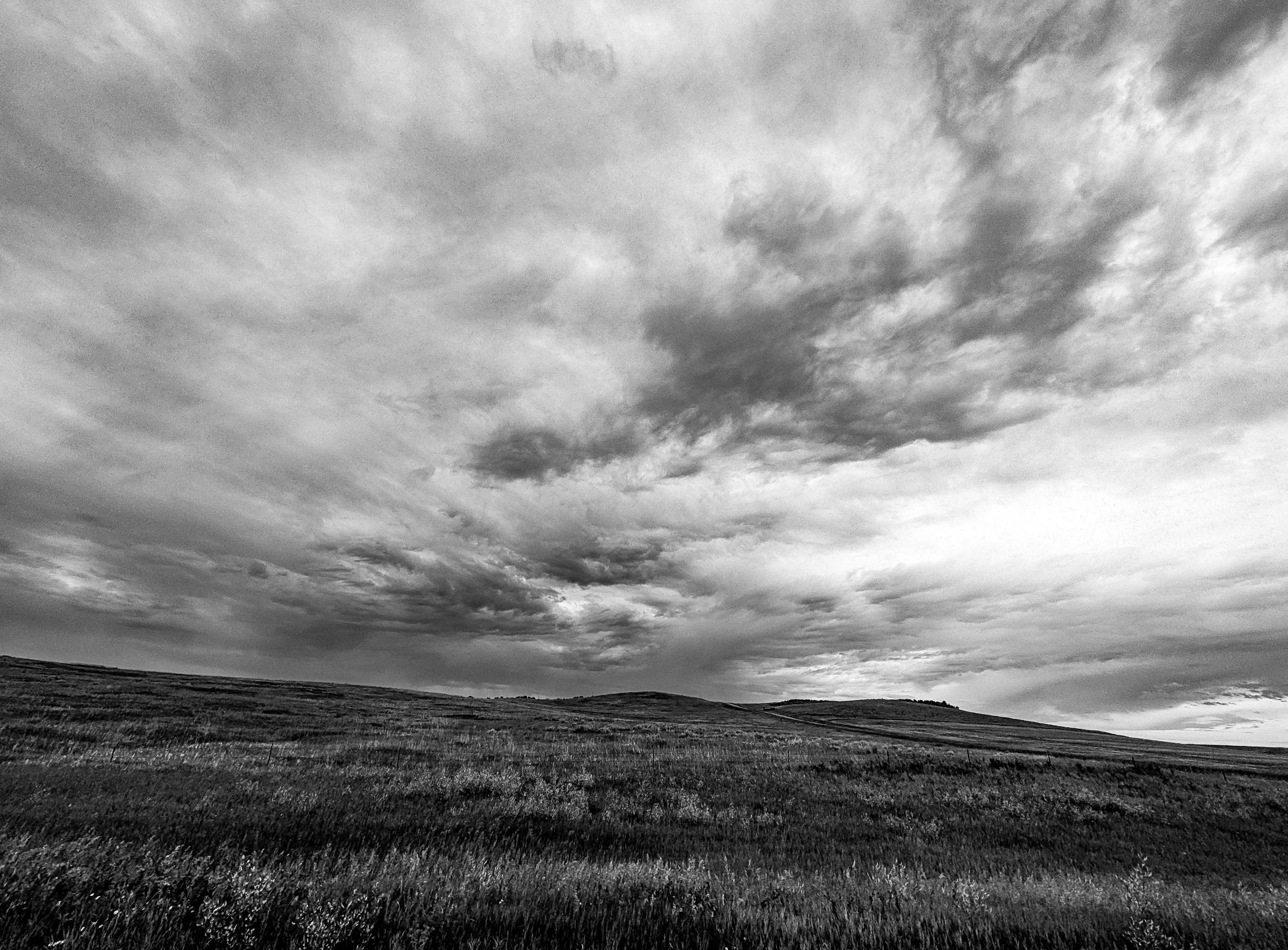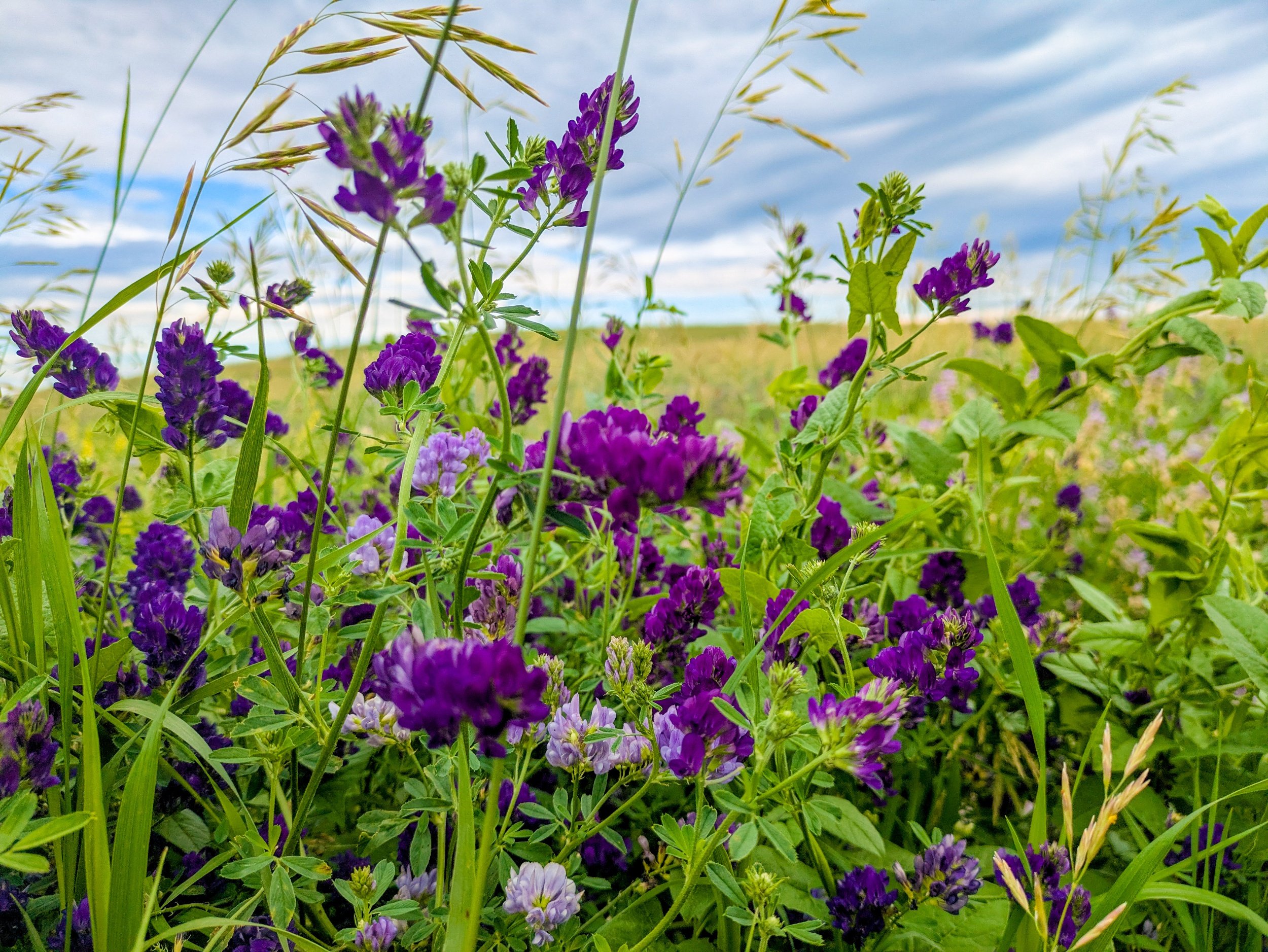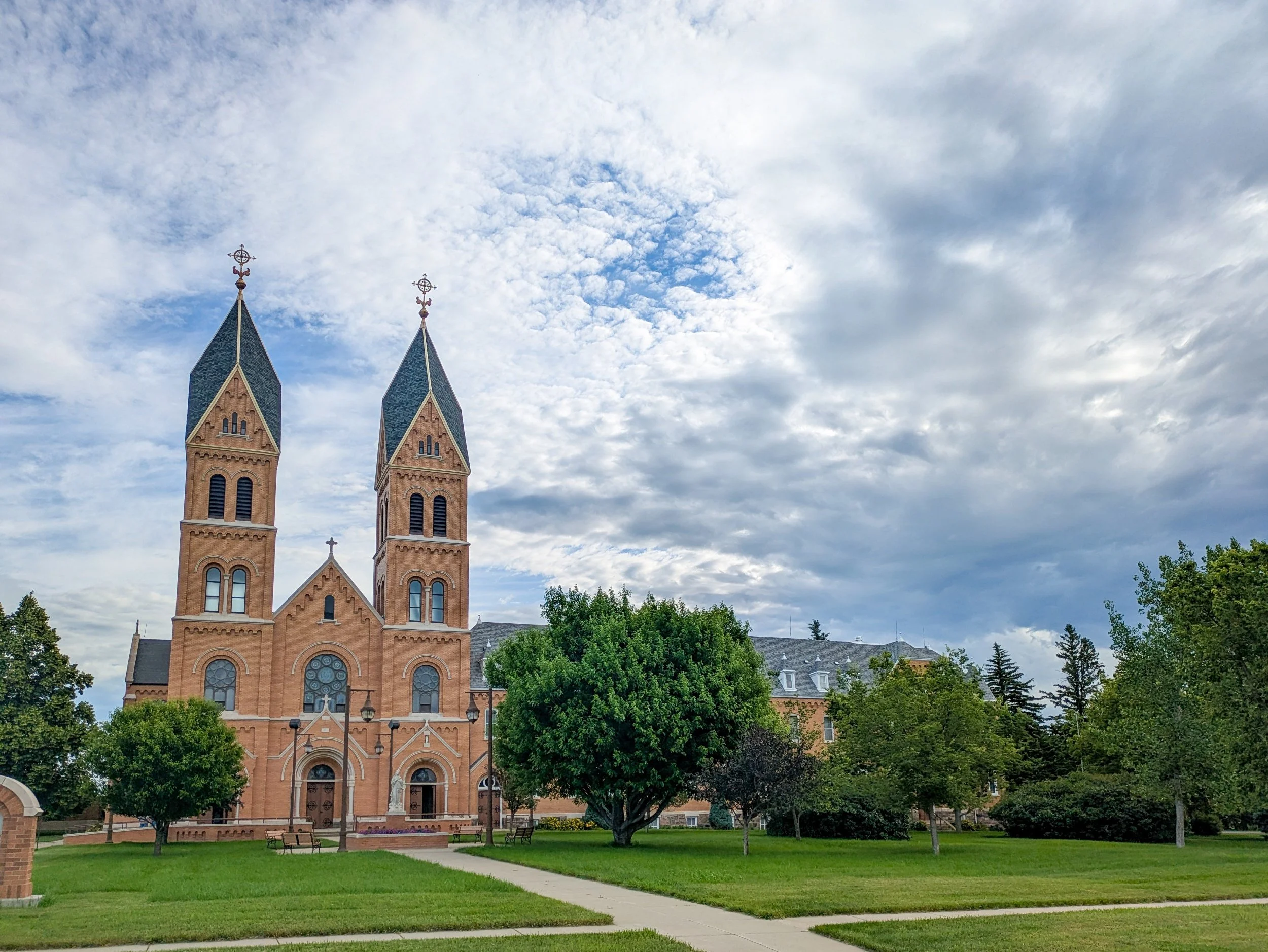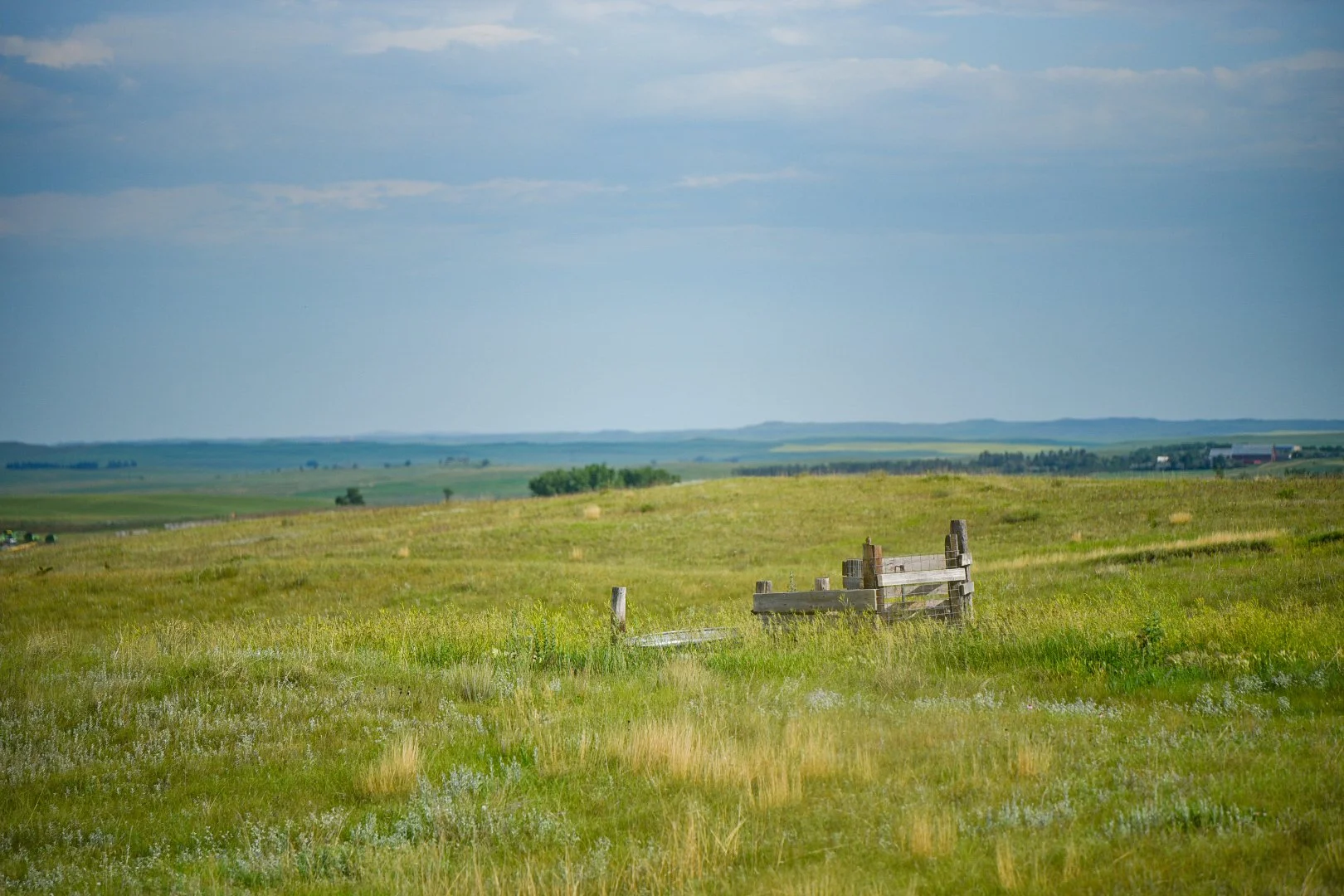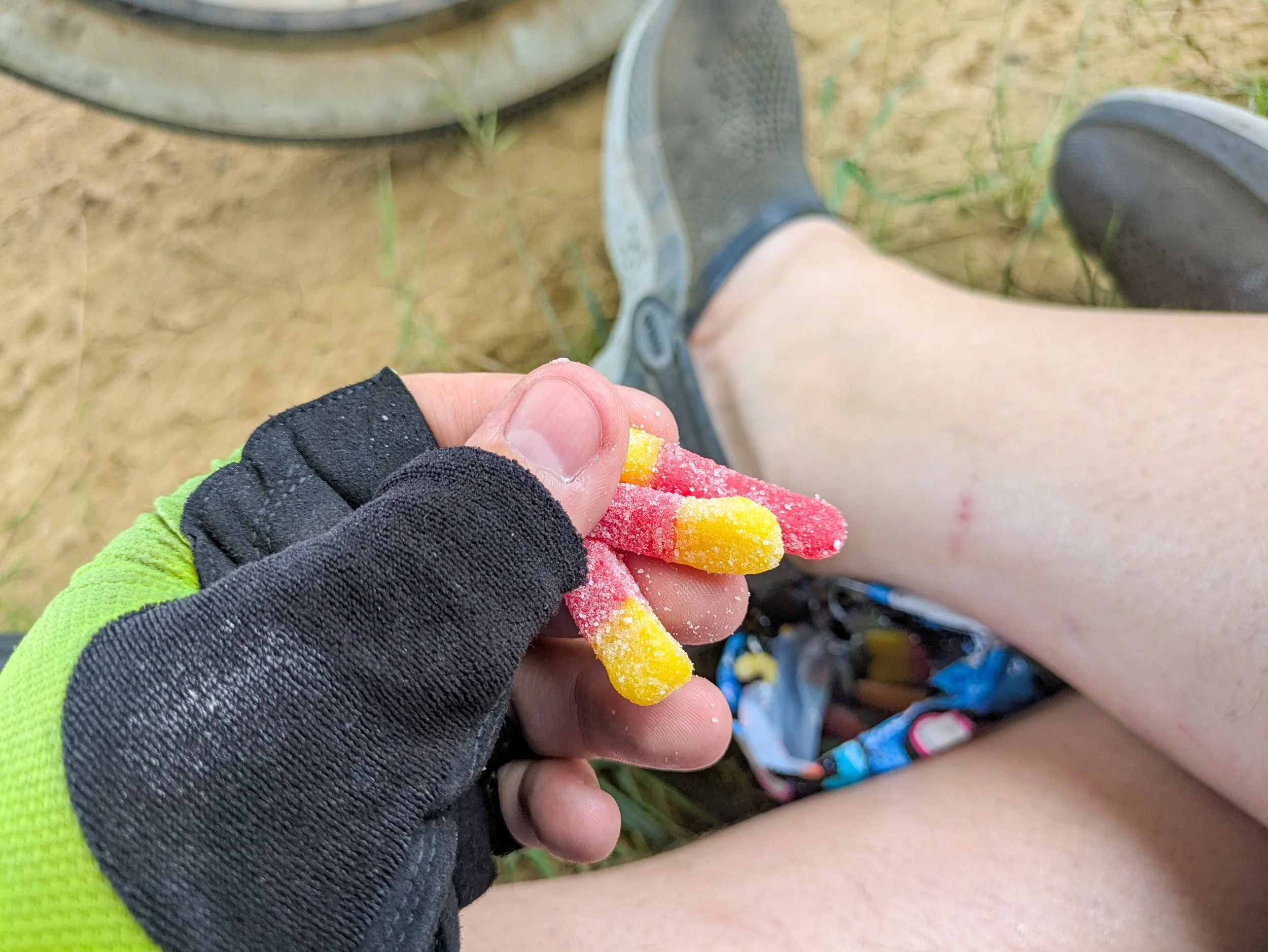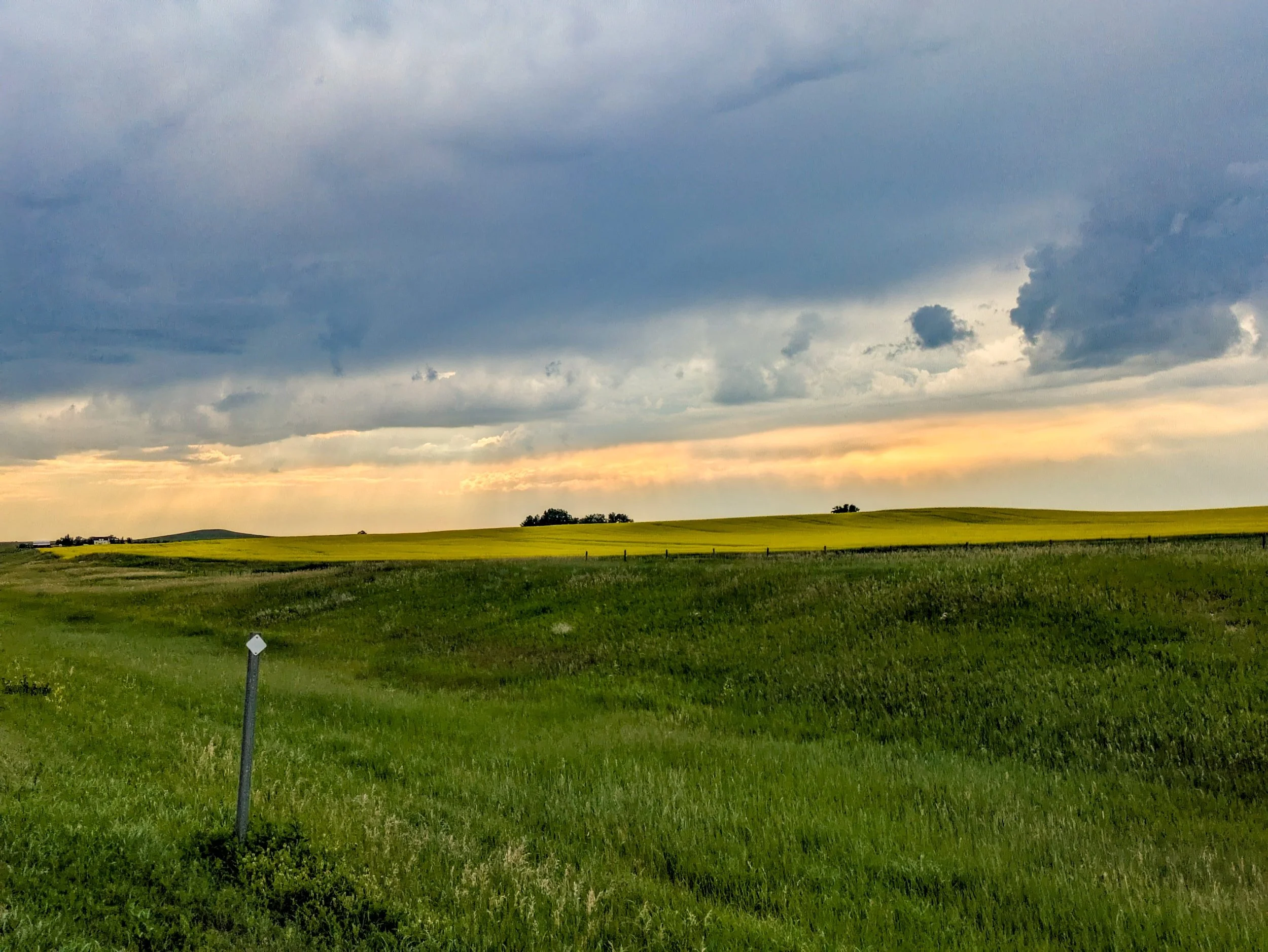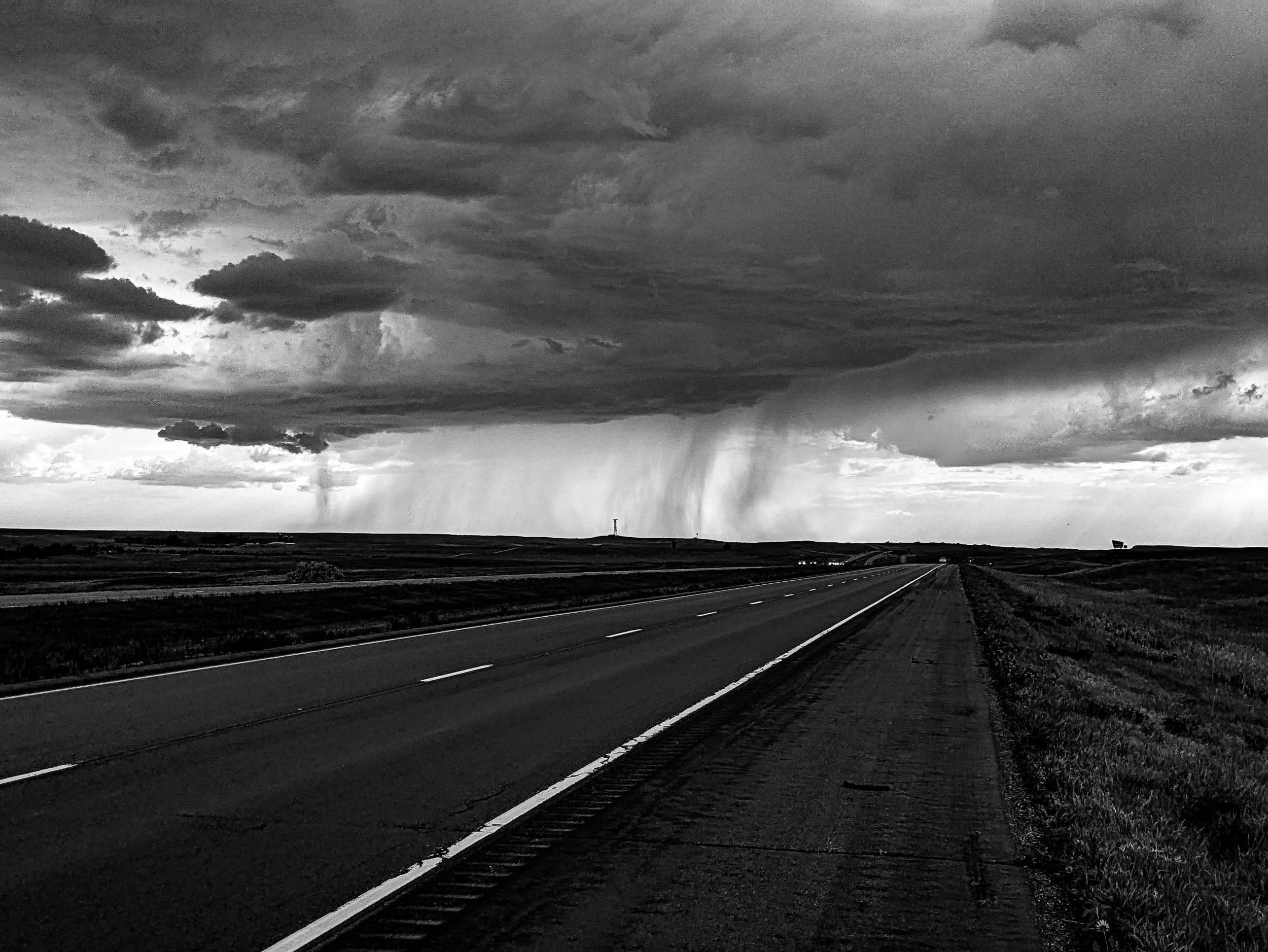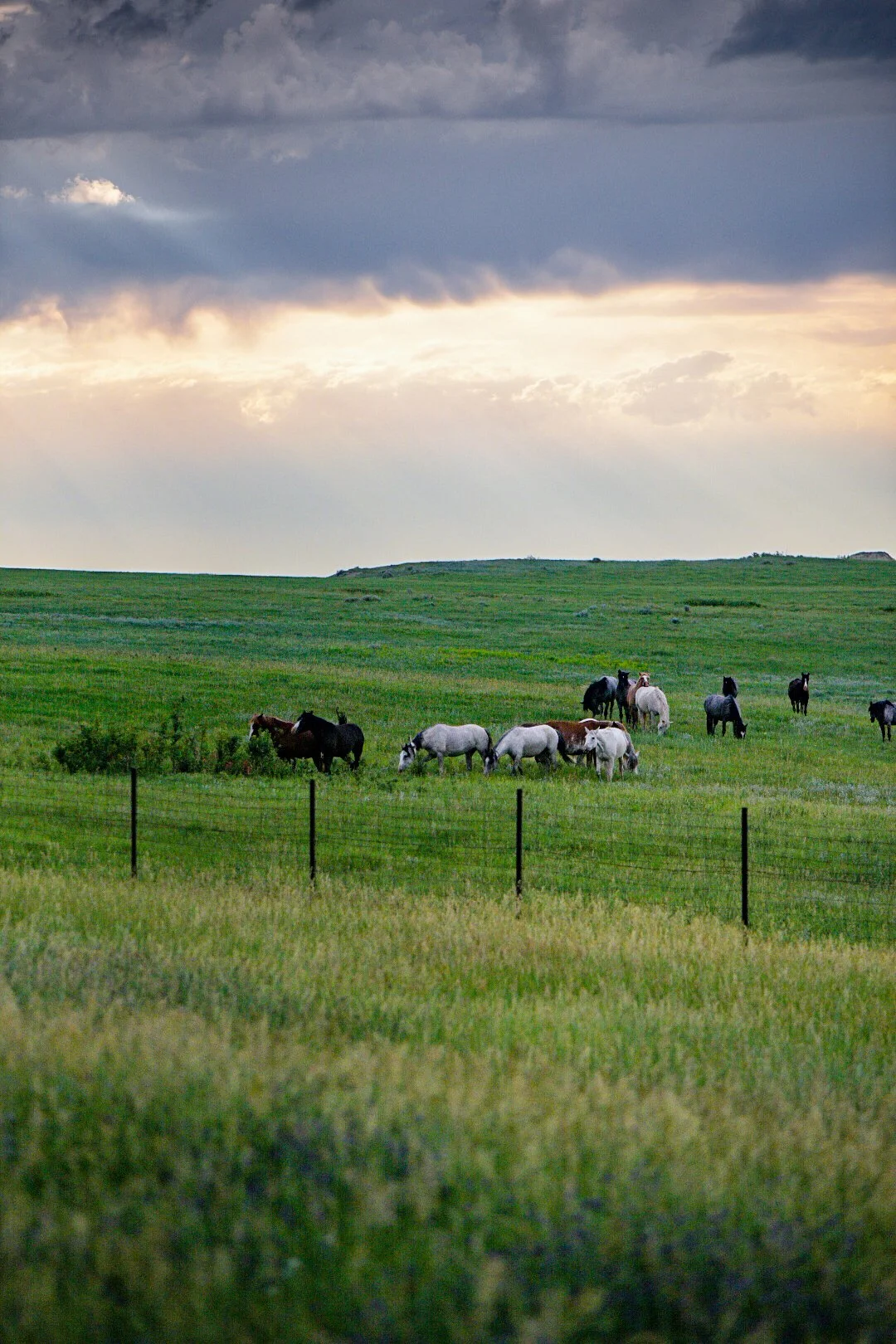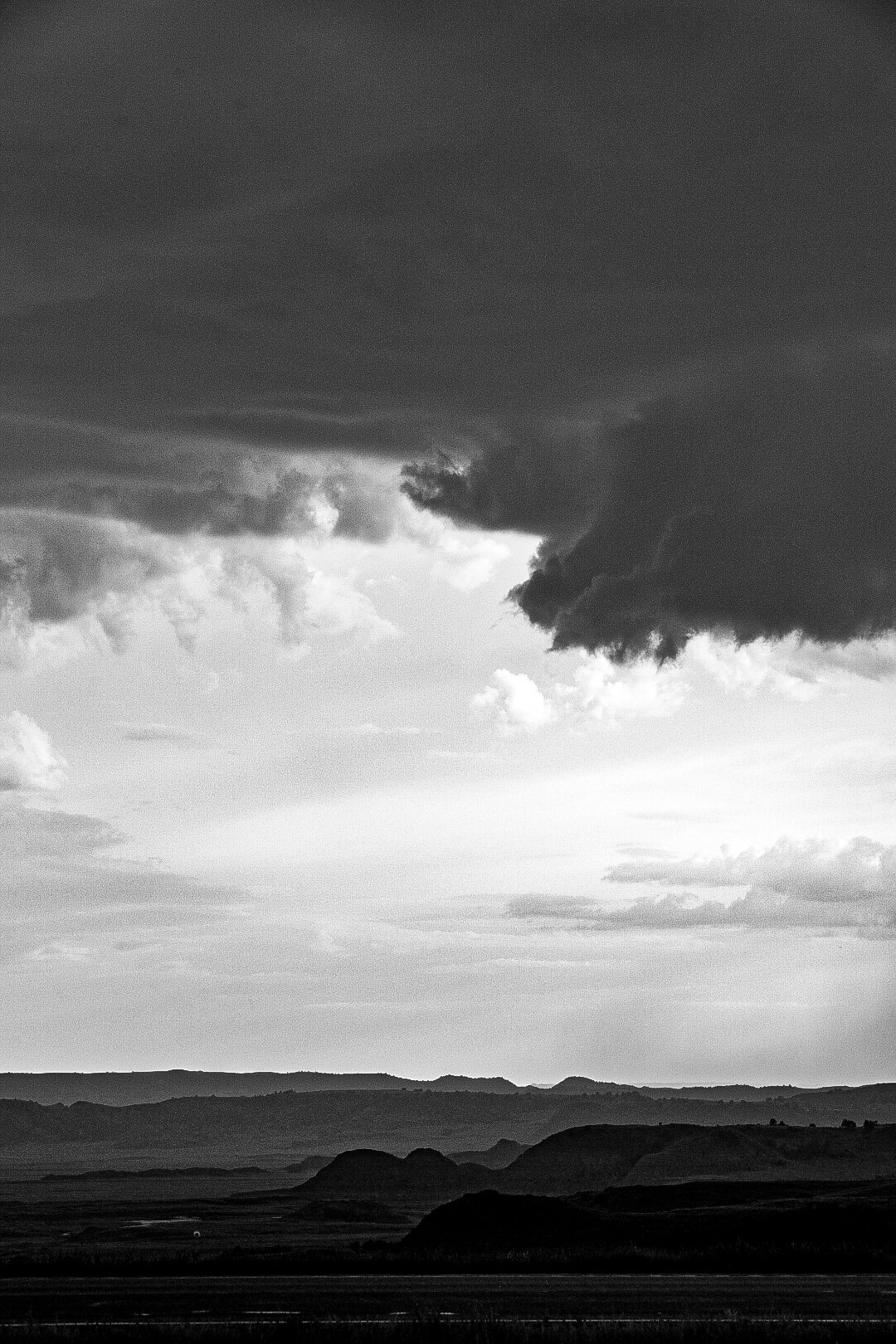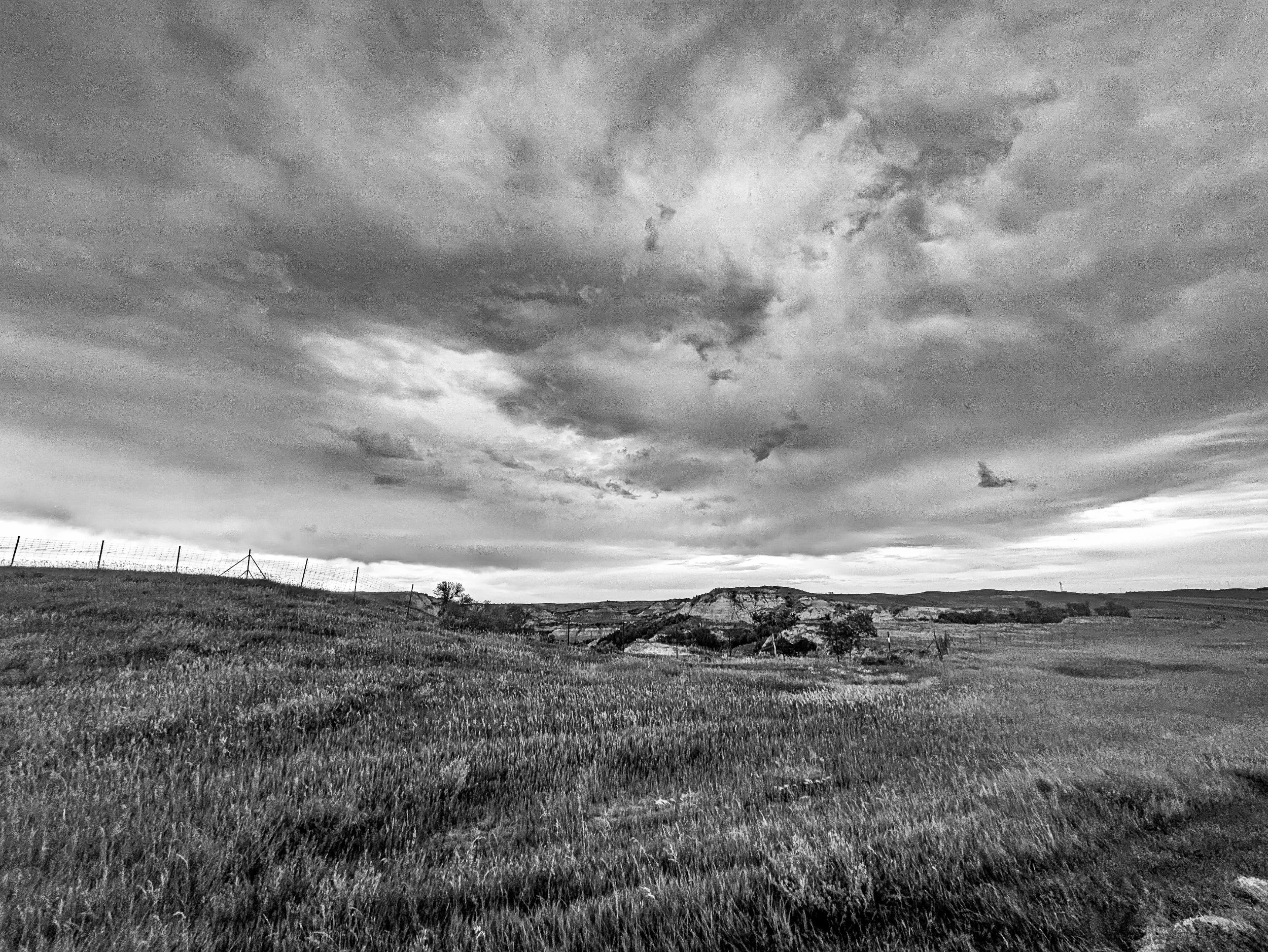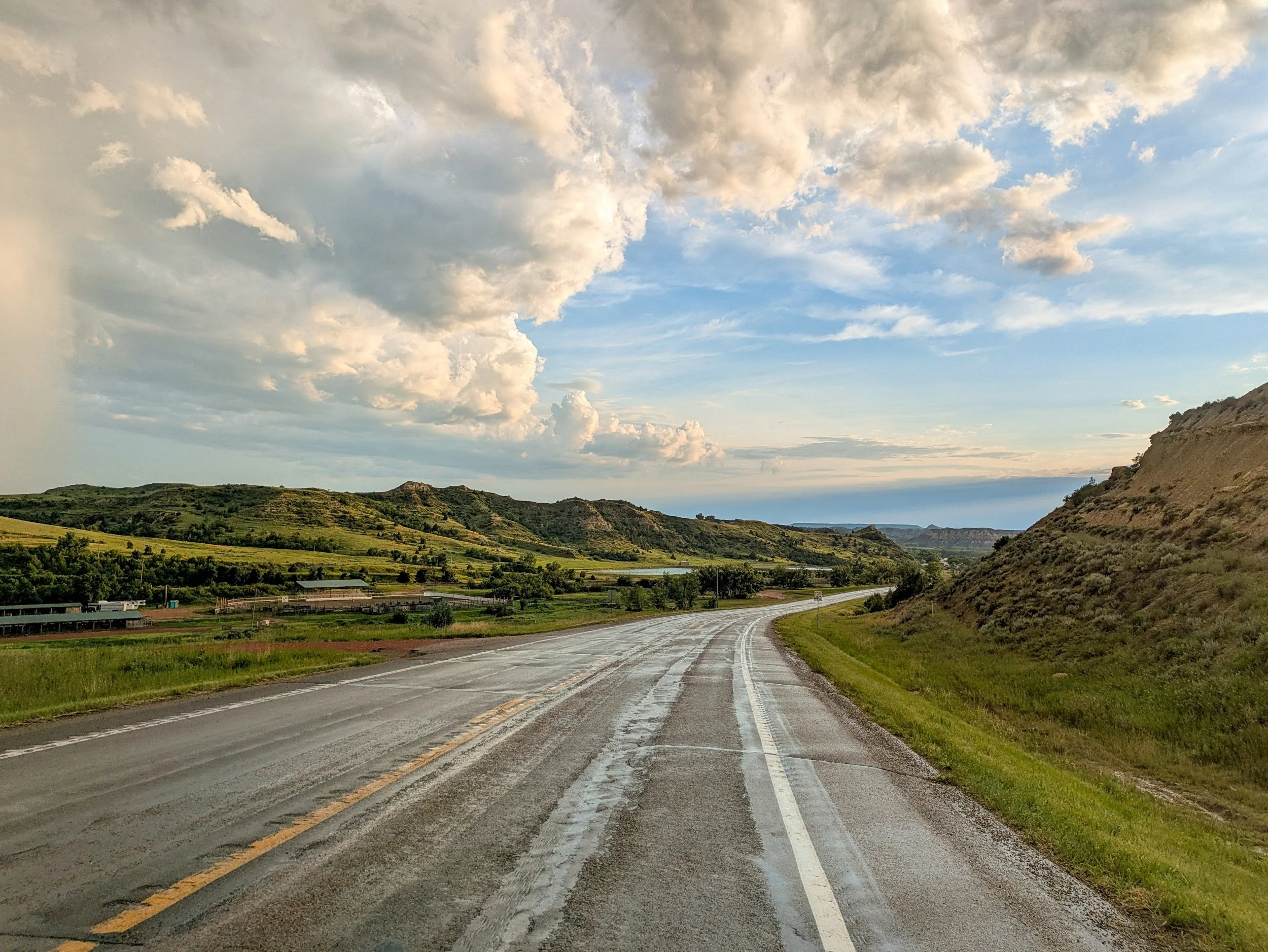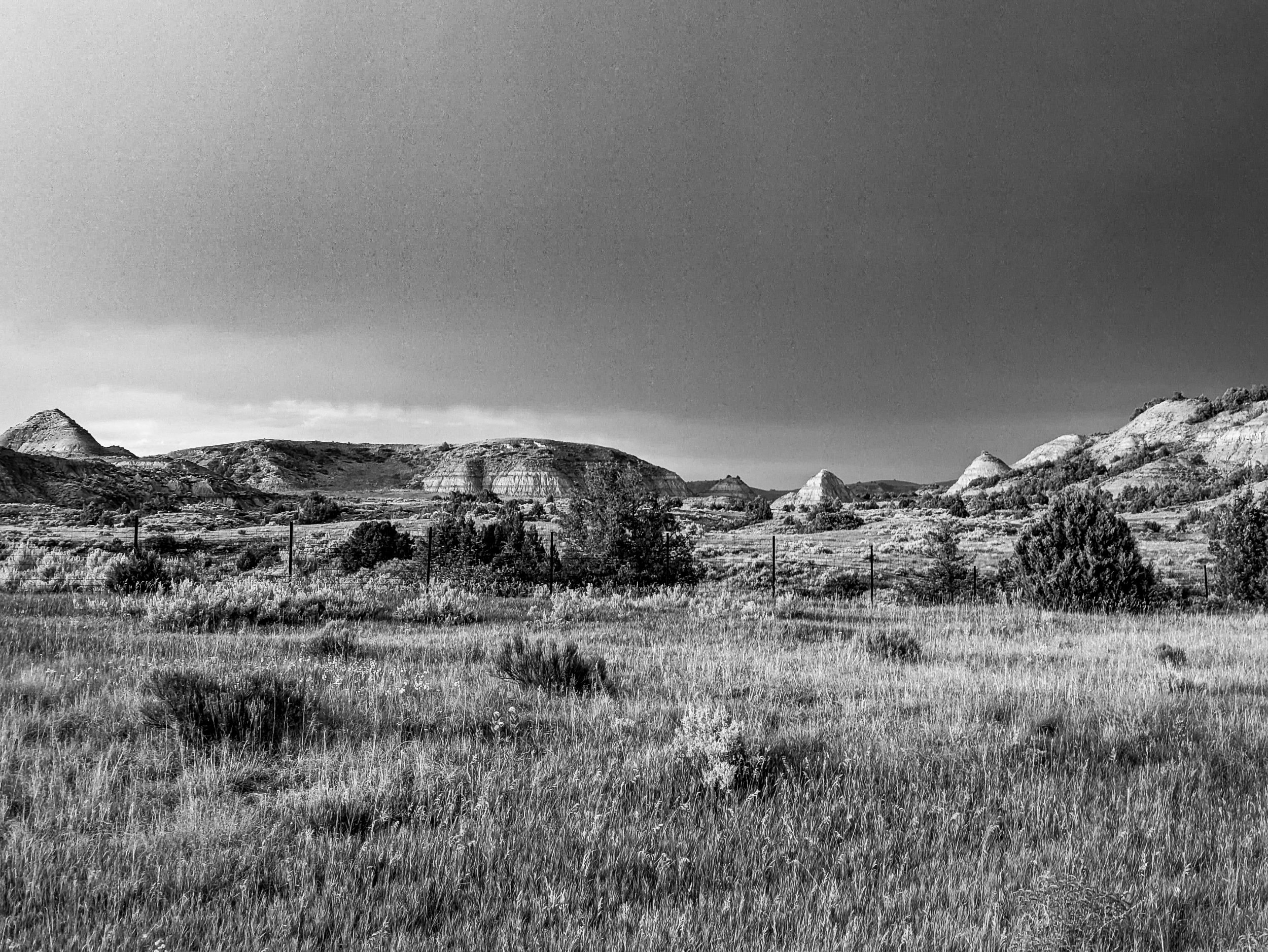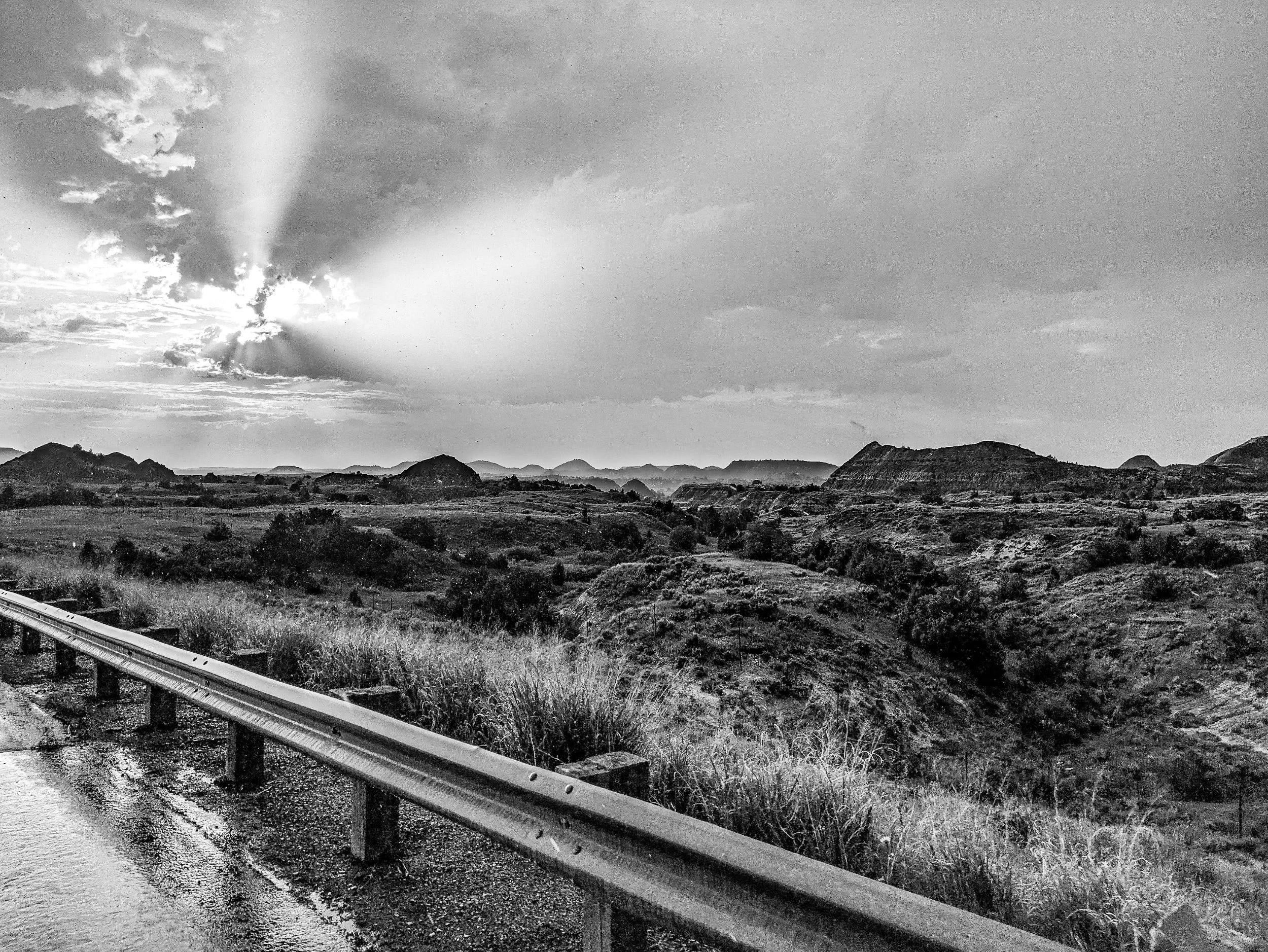Day 18 - to Medora, ND
I meant to sleep in…
Genuinely after the previous day of 76 miles I fully intended to sleep in to around 10am and then depart Hebron and simply make it to Dickinson. However when I woke up at 6:30 something within me said that Dickinson wasn’t far enough. My muscles were ready for another day of hard riding and so I rolled out of bed and out the door by 7:15am only to be greeted by the orange glow of the newly risen sun and some particularly interesting sky all of which led to me taking a considerable amount of pictures before truly departing the Hebron area.
Other than the dramatic sky, there really wasn’t anything functionally different about the terrain than the previous few days. Rolling hills of fields with occasional Buttes sticking out like alien pyramids on the surface of a green moon. There were more trees though. I think these were mostly groves or orchards intentionally planted for fruit or wood because they were highly ordered into lines spaced at even intervals. I’m not sure about what sort of crop trees they might grow out here, but I tend to think they were apples, and a quick Google search seems to confirm that there are productive apple farms in the region.
Moving out of the area required gradually climbing up a set of low hills over which the wild Alfalfa (medicago sativa) was in full bloom. I'm fascinated by this plant because a single plant can seemingly produce flowers from the lightest lilac to the deepest royal purple and anywhere between. By far my favorite splash of color are the deep and rich purples that account for a minority of the colors flashed, and every time I see it I think of my sister-in-law, who has a deep love of all things purple.
My morning set of miles took me towards Dickinson on highway 10. On the way I passed through a few small towns, almost always identified from a distance from grain elevators near the railroads that run through them. Occasionally these will also be situated next to an ethanol production facility — This isn’t ethanol for consumption. It’s the ethanol that’s added to consumer gasoline, and at times its reagent grade ethanol for use in the sciences.
As I stopped by one such of these plants I took a picture of my bike only to turn around and see an opportunity to snap a photo of a bird at rest on a post nearby:
The Upland Sandpiper (Bartramia longicauda) is frequently found on fenceposts because they allow excellent views of the area so it can spot prey insects. During the winter months the Sandpiper will migrate to Ecuador some 12,500 miles.
Passing through I eventually reached Richardton. I stopped at a roadside monument to veterans and spotted this plaque:
I’ve spoken about it before, but the American campaign to irradicate the indigenous people is something of a deep wound for me. When I saw this plaque and language it used to describe the Sioux as “hostile” for simply defending their right to exist after having treaty after treaty broken, it disgusted and enraged me. I pedalled away with angry tears streaming down my face. Partially because of our history of genocide and that we choose to continue to couch it in these terms, but more so because the parallels between the policy of manifest destiny, and the actions of the Israeli state against Palestinians for 80 years is a mirror image of those practices, and one that is currently happening.
It caused me to ponder how words are used to dehumanize and make it justifiable to kill other humans. Terrorist is the new Savage of old. If people can be labeled, their struggle, right or wrong can be reduced to the actions of non-human animals, who neither think the way we do or want the same things we do. They only know violence. We are simply defending our way of life.
The indigenous tribes were not perfect victims, as I have said before. But it is clear there was effectively no protest they could muster that would humanize their cause within the eyes of the US government at the time. Their existence was a stumbling block to progress. People respond differently to being relentlessly attacked. They either flee or they fight. Those who fought back were made to pay doubly. They were given the historical label “Hostile” or “Savage” simply for doing what many of us would have done in the same situation.
I often think about Alien invasion movies, or Red Dawn as a touchstone for understanding what it must have felt like. In these situations we identify with the beset group. What if they didn’t win in the end? What if their struggles were ultimately fruitless and they were killed or sent off to concentration camps? Was their struggle wrong because it didn’t end in victory?
I’m not trying to make them out to be heros. I’m trying to restore their humanity within the historical record.
But then the other side of the coin is that men like Custer or Sheridan or Jackson were also human, and their actions are not so uniquely evil that they aren’t easily repeated — clearly.
It left me in a hopeless place reflecting on how there are certain groups to whom there are no avenues of protest because any protest, any resistance is considered inappropriate, a hostility, or egregious. Kapernick knelt to protest police brutality and he was vilified as unpatriotic. Palestinians throwing rocks at a tank, deemed terroristic. Yet the responses never get judged by the same meter stick — rubber bullets to the head, teargas canisters to the teeth, the breaking and twisting of limbs, collateral damage in the form of a leveled hospital.
In the frictions between the indigenous people and the entire United States there was no real redress, not when those in power felt “The only good indians I’ve ever known were dead” — so said Sheridan (which was later misquoted to “the only good indian is a dead indian.”)
I challenge you, reader, to what group do you have those sentiments? Why?
At base people everywhere want the same things, hope for the same things, dream about the same things. Are Palestinians so much different than Israelis? Does it only come down to who God ordains to have the land, and if that God demands genocide to obtain it, or at least excusing as much… are they worth serving?
I thought of Abraham’s prayer when God told him of his plan to raze Sodom and Gommorah. In the back and forth Abraham asked if God would destroy it if there were 50 righteous in the city, and God said no. And what if there were 10? No. What about one? No.
Is this the sort of prayer we have for Gaza, or is it a prayer of utter destruction? Children, and Doctors, and Journalists, and Aid Workers, and Civilians — how many of their deaths are necessary? How many of the Indigenous people on our own continent needed to die so that America could expand?
I’m not asking you to agree with me. I’m simply asking you to contend with these questions. And I understand the great pretense of putting this essay hidden in a travel blog. But I’m just being true to the real thoughts I had based on my experiences in the moment. They are the fruit of my journey as much as all the other stories and pictures.
Before leaving Richardton I biked past Assumption Abbey, founded by Benedictine Catholics in 1899. Today it hosts some 56 monks. I can’t speak to their work or their reasons for being in Richardton of all places, but the building certainly was beautiful.
As the day wore on temperatures rose quickly and cloud cover burned off. As I neared Dickinson the exurban and suburban sprawl started to accelerate until I hit the main portion.
The portion of highway 10 I was on turned into an all-too-familiar urban blight of parkinglot hell interrupted by gas stations, shuttered businesses, a dollar general and some other unappealing buildings.
I searched around for a coffee house with outdoor outlets and indoor seating but found none. Instead I found myself zig zagging around the city looking for any place to eat that also had exterior outlets to no avail. Eventually I settled that I would go to the library after eating. I conferred with the front desk that it was OK to charge my bike and they agreed. So I spent three hours in a lovely old victorian styled library.
I don’t want to give you the impression that Dickinson is a run down city. The areas I went through to get to the library were lively and well kept, and the downtown seemed quite nice. But my bias from the difficulty in finding charging, and the oppressive 93 degree heat may have tainted my depiction.
I blogged for a while and then left to make the next leg to Belfield.
The 22 miles to Belfield were largely just wide open spaces with sparse housing. Mostly open grassland with a few farms dotting the landscape. Otherwise it was not significantly different other than being oppressively hot. To this point I estimate I had worked my way through over two gallons of fluid and my muscles were starting to flag. So I found the only cover that I could — a highway underpass and had some gummy worms to try and boost my energy.
I arrived in Belfield about an hour later, around 5:30pm with a battery nearing empty and a body wanting to quit.
Earlier in the day I had arranged for a camping spot in Medora because there was literally no other lodging options. Even the only single room still available I could find in a 30 mile radius was $280 — no thanks. So I contacted the campground there and secured a powered site with access to shower for $45. I just had to get there.
I ate an unsatisfying dinner of gas station fried chicken and waited until 7:30pm to head out to try and make the final 17 miles. All on the interstate. I had deep doubts about my battery, my legs, my resolve. My morale was low and I was settling in for a grind…
Instead of settling into a grind, I was ushered into the church of the elemental.
As the sun lowered in the sky, it took on vanilla tones. Rainstorms could be seen far off. Horses played in fields as I rode by.
Onward I rode up and up over the course of miles, mounting some unseen brim ahead of me as stormclouds were driven towards me. Lightning flashing across the sky and to the ground in localized clusters.
Gradually, mile by mile I was being lifted up over the prairie floor. Until I rounded a bend and the light glinted off painted hills:
Radiohead was my soundtrack as lightning burst above my head, the sun was setting in front of me, and the clouds were pelting me with cold, sharp darts of rain or hail, I’m not quite sure, and a double rainbow behind. I contemplated getting down on my knees on the wet pavement but instead rode forward with an overwhelming sense of awe and appreciation for the splendor of the Earth, crying, laughing.
The intensity of the rain and the lightning increased and so did my pace. As I came down the other side of the lip the terrain opened up into a thousand canyons, all with their own painted walls.
A girl hung her body out of an SUV window shouting me onward, pumping her fist.
Eventually I was out of the rain and past the hills, having descended down to the river level. What should have been 17 tiresome, toil filled miles were exuberant, buoying.
I pulled into the campground and up to the registration area at around 9pm, and the woman behind the desk showed me to my spot. There was still about 45 minutes of usable light, and rain was a real threat.
So I found myself setting up a tent I had yet to use, and laying out my bedding for the night. My bike would have to charge in the elements, but I made sure the charger was covered by a waterproof bag. The only point for any possible water intrusion was the barrel plug going into the bike, and I new that was weather sealed around its base.
After getting settled and taking a shower I crawled into my cave-like tent and tried too sleep. Feral children were gleefully and loudly scurrying about the campground and so I was nearly asleep by 11 until I was startled awake by the sound of lightning and they patter of rain on my tent.
Eventually by 12:30 I was able to sleep but after rolling over a lightning bolt flashed brighter than I had ever seen, and without delay I felt the thunder within me. A tree 50ft from my tent had been struck I would later find out.
Eventually I was able to get back to sleep. And that’s how my day ended.




